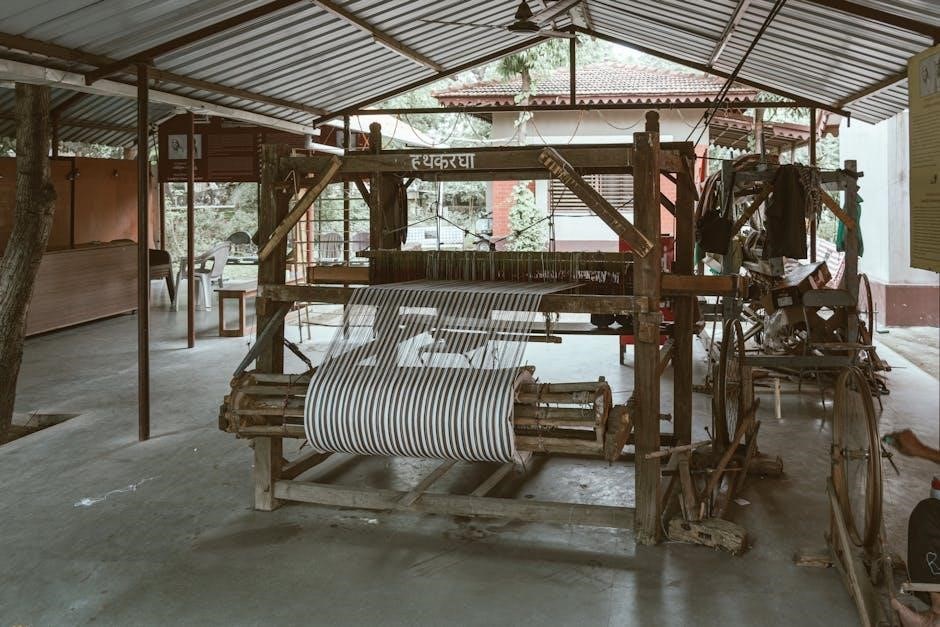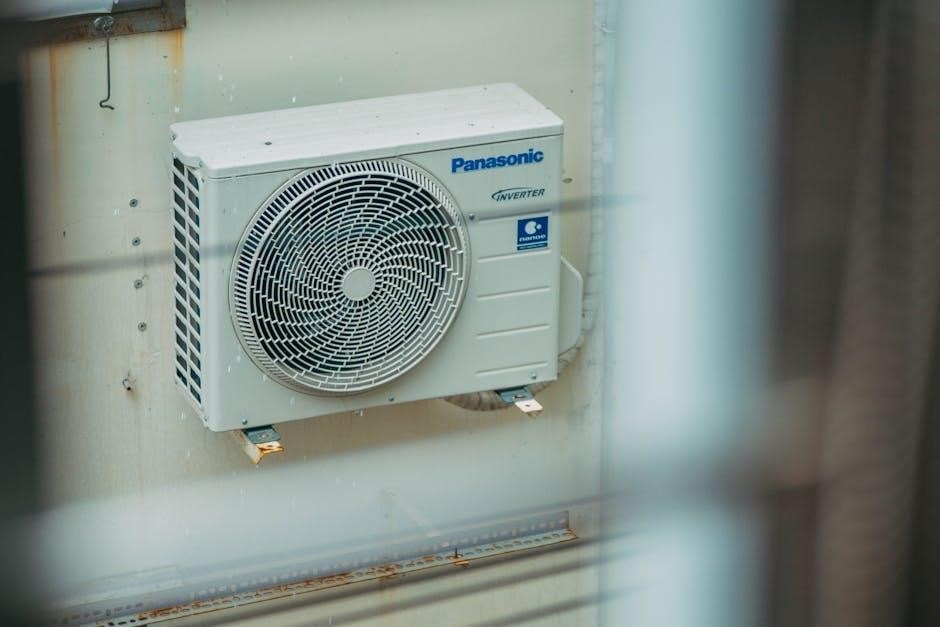Welcome to the FS-Curtis Air Compressor Manual. This guide provides essential information for safe installation, operation, and maintenance of your compressor, ensuring optimal performance and longevity.

Safety Precautions and Guidelines

Ensure personal safety and equipment longevity by following all safety instructions in this manual. Always disconnect power before maintenance and adhere to operational guidelines to prevent hazards.
2.1 Importance of Safety
Safety is paramount when operating the FS-Curtis air compressor. Neglecting safety guidelines can lead to severe personal injury or equipment damage; Always read and understand the manual thoroughly before starting operations. Proper safety practices prevent accidents caused by electrical hazards, rotating parts, and hot surfaces. Ensure all warnings and precautions are followed meticulously. Regular maintenance and inspections are crucial to uphold safety standards. Familiarize yourself with emergency procedures and ensure proper training for all users. Adherence to safety protocols ensures reliable performance and extends the lifespan of the compressor. Safety must never be compromised to guarantee a safe working environment and optimal equipment functionality.
2.2 General Safety Guidelines
Adhering to general safety guidelines is critical when working with the FS-Curtis air compressor. Always disconnect the power source before performing maintenance or repairs. Wear appropriate personal protective equipment, including safety glasses and gloves, to minimize risks. Ensure proper ventilation in the workspace to prevent accumulation of hazardous gases or fumes. Regularly inspect the compressor and its components for wear or damage; Never operate the compressor near open flames or sparks, as this could ignite flammable substances. Keep loose clothing and long hair tied back to avoid entanglement with moving parts. Avoid touching hot surfaces, such as compressors or pipes, during operation. Ensure all personnel are properly trained and understand the compressor’s controls and functions. Follow all manufacturer instructions to ensure safe and efficient operation.

Installation and Setup

- Ensure proper site preparation and unpacking of the compressor.
- Follow electrical installation guidelines as per the manual;
- Ensure the foundation is level and suitable for the compressor.
- Connect all components according to the system flow chart.
- Test the setup to confirm correct operation.
3.1 Receiving and Inspection
Upon receiving the compressor, inspect the shipment for completeness and damage. Verify that all components, including the compressor unit, accessories, and documentation, are included and undamaged. Check for any signs of shipping damage, such as dents, scratches, or loose parts. Ensure the model and serial number match your order. If any discrepancies or damage are found, contact your authorized FS-Curtis distributor immediately. Carefully unpack the compressor and place it on a stable, level surface. Inspect all electrical connections and components for integrity. Review the provided documentation, including the manual, to familiarize yourself with the unit before proceeding with installation. Proper inspection ensures a smooth installation process and prevents potential issues during operation.
3.2 Electrical Installation
Electrical installation must be performed by a qualified electrician to ensure compliance with National Electric Code, state, and local regulations. Proper grounding of the compressor package is essential to prevent controller malfunction. The power supply wiring should strictly follow the wiring diagram specific to your compressor model, provided in the manual. Ensure the compressor is connected to a dedicated electrical circuit that matches its voltage, phase, and current ratings. Avoid using extension cords, as they can cause voltage drops and operational issues. The power supply must be disconnected for at least 15 seconds before restarting to prevent error codes. Always refer to the wiring diagram and safety guidelines in the manual for a safe and correct electrical setup.
3.3 Foundation and Leveling Requirements
Ensure the compressor is installed on a solid, level surface to minimize vibration and prevent operational issues. Select a foundation that is flat and sturdy enough to support the compressor’s weight. For screw-type compressors, constructing a separate base is unnecessary due to their relatively low vibration levels. However, ensure the surface is even and free from obstructions. Use leveling pads or shims to achieve proper alignment, as specified in the manual. Improper leveling can lead to uneven wear, reduced efficiency, or equipment damage. Always follow the manufacturer’s guidelines for foundation preparation to ensure safe and reliable operation of the FS-Curtis air compressor.

System Components and Functionality
The FS-Curtis air compressor comprises essential components such as the air filter, oil filter, motor, oil separator, intake valve, and pulley, working together to compress air efficiently.
4.1 Overview of Components
The FS-Curtis air compressor system includes key components such as the air filter, oil filter, motor, oil separator, intake valve, and pulley. These parts work together to ensure efficient air compression. The air intake filter cleans the incoming air, while the oil filter maintains oil quality. The motor powers the system, and the oil separator divides oil from compressed air. The intake valve regulates air flow, and the pulley drives the compressor. Additional components like the after cooler and 2-way solenoid valve further enhance performance by cooling compressed air and controlling oil flow. Understanding these components is crucial for proper operation and maintenance, ensuring the compressor runs smoothly and efficiently.
4.2 Air/Oil Flow Explanation
The FS-Curtis air compressor operates on a precise air/oil flow system. Air enters through the air filter and intake valve, mixing with oil to lubricate and cool the compression chamber. During compression, the air/oil mixture is compressed and then directed to the oil separator, where the oil is removed and recirculated. The separated air is cooled in the after cooler, reducing its temperature before discharge. This process ensures efficient compression, cooling, and separation of air and oil, maintaining optimal performance and preventing overheating. Proper air/oil flow is critical for the compressor’s functionality and longevity, ensuring clean and reliable compressed air output for various applications.

Operating the Compressor
Operating the FS-Curtis air compressor involves following a structured startup procedure and monitoring operations to ensure efficiency. Always check oil levels and ensure proper airflow before starting. Safety is paramount; disconnect power before maintenance and monitor for unusual noise or vibration. Regular inspections and adherence to guidelines ensure reliable performance and longevity of the compressor.
5.1 Startup Procedure
Starting the FS-Curtis air compressor involves a systematic process to ensure safe and efficient operation. Begin by inspecting all components for damage or leaks. Ensure the power supply is correctly connected and the compressor is properly grounded. Check the oil level in the sight glass or gauge, ensuring it is within the recommended range. Next, turn on the power and allow the motor to start. The compressor will begin compressing air, and the pressure gauge will rise. Once operational, monitor the system for unusual noise, vibration, or temperature fluctuations. Allow the compressor to run without load for a few minutes to ensure smooth operation. Finally, check the air output and ensure all safety features are functioning correctly. Always refer to the manual for specific startup instructions tailored to your model.
5.2 Monitoring Operations
Continuous monitoring of the FS-Curtis air compressor is essential to ensure efficient operation and prevent potential issues. Regularly check the pressure gauges to confirm the system is operating within the recommended range. Monitor the temperature of the compressor and components, as excessive heat can lead to damage or shutdown. Ensure the oil level is within the specified range and inspect the oil quality for contamination. Drain condensate from the air receiver to prevent liquid buildup; Listen for unusual noises or vibrations, which may indicate misalignment or worn parts. Always ensure safety features, such as overload protection and pressure relief valves, are functioning correctly. Refer to the manual for specific monitoring guidelines tailored to your compressor model to maintain optimal performance and longevity.

Maintenance and Servicing
Regular maintenance is crucial for optimal performance and longevity of the FS-Curtis air compressor. It involves daily, weekly, and monthly tasks to ensure all components function correctly.
6.1 Daily Maintenance Tasks
Daily maintenance is essential to ensure the compressor operates efficiently and safely. Begin by checking the oil level in the compressor and topping it up if necessary. Inspect the air filter for cleanliness and replace it if clogged or damaged, as dirty filters can reduce performance. Drain condensate from the air receiver to prevent moisture buildup. Monitor the temperature and pressure gauges to ensure they are within the recommended ranges. Additionally, listen for unusual noises or vibrations, which could indicate potential issues. Finally, ensure all safety guards are in place and that the surrounding area is clean and well-ventilated. Regular daily checks help prevent unexpected downtime and extend the compressor’s lifespan.
6.2 Weekly Maintenance Tasks
Performing weekly maintenance ensures your FS-Curtis air compressor runs efficiently and reliably. Start by inspecting the air filter for dust or debris and cleaning or replacing it as needed. Check the oil level and top it off if necessary, ensuring the compressor remains properly lubricated. Inspect the compressor’s belts for signs of wear, such as cracks or fraying, and adjust or replace them if required. Additionally, examine the drain valve and ensure it is functioning correctly to prevent moisture buildup. Finally, inspect the electrical connections and wiring for any damage or loose connections. Regular weekly maintenance helps prevent unexpected issues and ensures consistent performance. Always refer to the manual for specific instructions tailored to your compressor model.
6.3 Monthly Maintenance Tasks
Monthly maintenance is crucial for ensuring the longevity and efficiency of your FS-Curtis air compressor. Begin by changing the oil every 500 hours of operation or monthly, whichever comes first, using the recommended grade specified in the manual. Inspect and clean or replace the air/oil separator element to maintain proper lubrication and compression efficiency. Check the cooling system for blockages and clean the condenser coils if necessary to ensure optimal heat dissipation. Additionally, inspect the condensate drain for proper function and drain any accumulated moisture to prevent rust or corrosion. Finally, verify the integrity of all hoses and connections, tightening any loose fittings. Regular monthly maintenance ensures reliable performance and prevents costly repairs. Always follow the manufacturer’s guidelines for specific tasks and intervals.

Troubleshooting Common Issues
Common issues include high discharge temperature, low pressure, and oil leaks. Refer to the error code list for specific solutions and perform routine checks to resolve problems quickly.
7.1 Identifying Common Problems
Common issues with FS-Curtis air compressors include high discharge temperature, low pressure output, and oil leaks. These problems often arise from improper installation, insufficient maintenance, or component wear. Error codes displayed on the controller can help diagnose specific faults. For example, high temperature alarms may indicate cooler issues or blocked air filters. Low pressure could result from leaks in the system or malfunctioning valves. Regularly checking the oil level and filter condition can prevent many of these issues. Refer to the troubleshooting section in the manual for detailed error code explanations and repair steps. Addressing these problems promptly ensures reliable operation and extends the compressor’s lifespan.
7.2 Error Codes and Solutions
FS-Curtis air compressors use error codes to indicate specific issues. For example, E01 signifies high discharge temperature, often due to a blocked air filter or malfunctioning cooler. E02 indicates low oil levels, requiring immediate refill. E03 points to high pressure, suggesting a faulty pressure regulator. E04 signals low airflow, possibly caused by leaks or obstructed intake valves. Refer to the manual for a complete list of codes. Solutions include checking and cleaning filters, ensuring proper oil levels, and inspecting for system leaks. Always disconnect power before performing repairs. If issues persist, consult the troubleshooting guide or contact an authorized FS-Curtis service provider for assistance. Timely resolution of these codes ensures efficient compressor operation and prevents further damage.
This concludes the FS-Curtis Air Compressor Manual. For further details, refer to the official FS-Curtis website or contact authorized distributors for additional resources and support.
8.1 Final Thoughts

